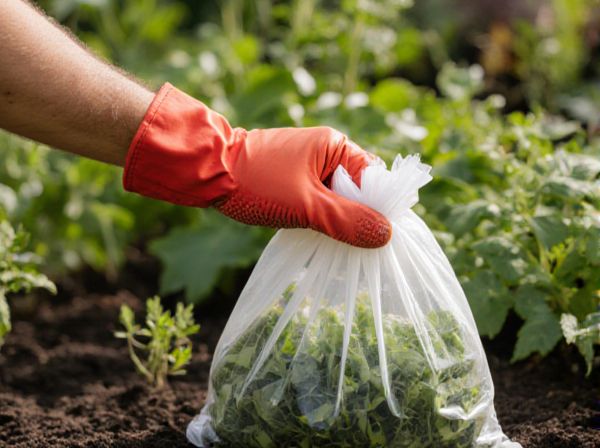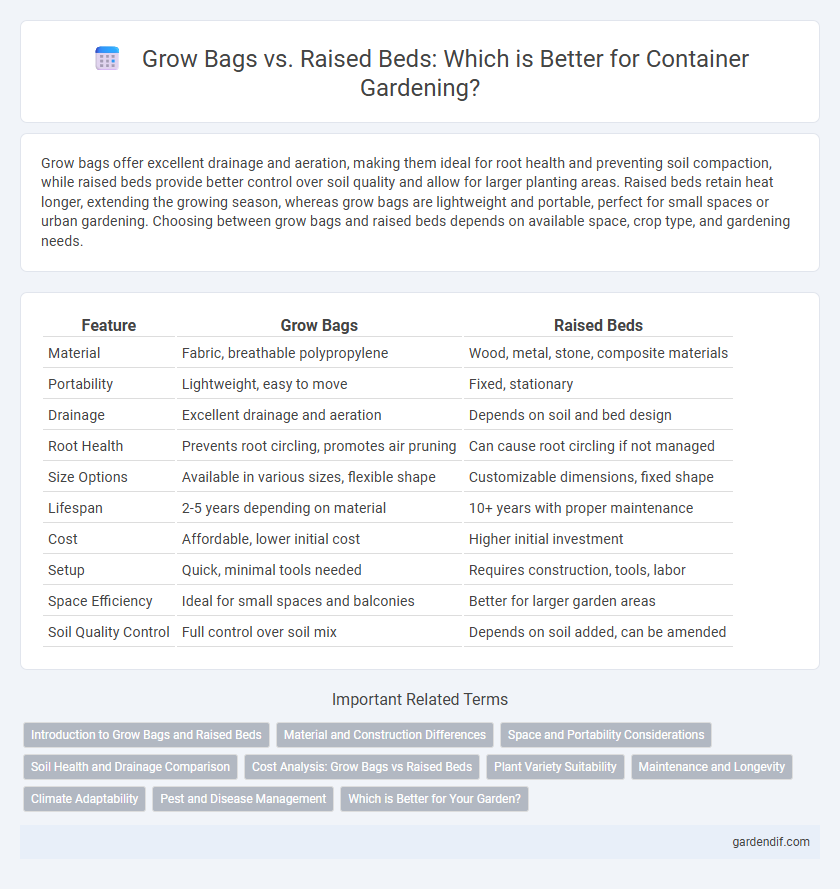
Grow bags vs Raised beds Illustration
Grow bags offer excellent drainage and aeration, making them ideal for root health and preventing soil compaction, while raised beds provide better control over soil quality and allow for larger planting areas. Raised beds retain heat longer, extending the growing season, whereas grow bags are lightweight and portable, perfect for small spaces or urban gardening. Choosing between grow bags and raised beds depends on available space, crop type, and gardening needs.
Table of Comparison
| Feature | Grow Bags | Raised Beds |
|---|---|---|
| Material | Fabric, breathable polypropylene | Wood, metal, stone, composite materials |
| Portability | Lightweight, easy to move | Fixed, stationary |
| Drainage | Excellent drainage and aeration | Depends on soil and bed design |
| Root Health | Prevents root circling, promotes air pruning | Can cause root circling if not managed |
| Size Options | Available in various sizes, flexible shape | Customizable dimensions, fixed shape |
| Lifespan | 2-5 years depending on material | 10+ years with proper maintenance |
| Cost | Affordable, lower initial cost | Higher initial investment |
| Setup | Quick, minimal tools needed | Requires construction, tools, labor |
| Space Efficiency | Ideal for small spaces and balconies | Better for larger garden areas |
| Soil Quality Control | Full control over soil mix | Depends on soil added, can be amended |
Introduction to Grow Bags and Raised Beds
Grow bags and raised beds are popular gardening solutions designed to optimize soil conditions and improve plant growth in limited spaces. Grow bags are made from breathable fabric that enhances root aeration and prevents waterlogging, while raised beds offer structured soil elevation for better drainage and temperature control. Both methods provide accessible, efficient alternatives to traditional in-ground gardening, suited for urban environments and small-scale cultivation.
Material and Construction Differences
Grow bags are typically made from breathable, fabric materials like felt or polypropylene, allowing for superior aeration and root pruning compared to raised beds, which are often constructed from wood, metal, or plastic panels providing rigid, durable containment. The lightweight and flexible construction of grow bags enables easy mobility and storage, whereas raised beds require more permanent installation with solid framing and drainage solutions. Material choice directly impacts moisture retention, insulation, and longevity, making grow bags ideal for temporary or small-scale gardening while raised beds suit long-term, extensive cultivation.
Space and Portability Considerations
Grow bags offer superior portability, making them ideal for limited spaces like balconies and small patios, whereas raised beds require a fixed location with more space and are less easy to move. Grow bags can be folded and stored when not in use, optimizing space efficiency, while raised beds provide more soil volume and long-term stability but lack flexibility. For urban gardeners prioritizing space-saving and ease of relocation, grow bags are the practical choice, but raised beds are preferred for permanent setups with generous outdoor areas.
Soil Health and Drainage Comparison
Grow bags provide superior drainage due to their breathable fabric, which prevents waterlogging and promotes oxygen flow to roots, enhancing soil aeration and microbial activity. Raised beds typically offer deeper soil profiles and better control over soil composition, supporting nutrient-rich environments but may require careful management to avoid poor drainage or compacted soil layers. Both options support healthy root systems, but grow bags excel in preventing water retention issues, while raised beds allow for more extensive soil improvements.
Cost Analysis: Grow Bags vs Raised Beds
Grow bags generally offer a lower initial cost compared to raised beds, with prices ranging from $5 to $20 per bag depending on size and material, while raised beds can cost between $50 and $300 or more based on size and construction materials like wood, metal, or composite. Grow bags are lightweight and easy to replace, reducing long-term maintenance expenses, whereas raised beds may require periodic repairs or replacements, increasing lifetime costs. For budget-conscious gardeners, grow bags provide a cost-effective, flexible option, while raised beds offer durability and structure that may justify higher upfront investments.
Plant Variety Suitability
Grow bags offer flexibility for a wide variety of plants, especially root vegetables and small to medium-sized herbs and flowers due to their excellent aeration and drainage. Raised beds support a broader range of plant varieties, including larger vegetables like tomatoes, peppers, and even fruit bushes, thanks to their deeper soil profile and improved soil quality control. Both options enhance plant health, but raised beds are typically better for plants requiring more space and nutrient-rich soil environments.
Maintenance and Longevity
Grow bags require regular monitoring to prevent soil compaction and ensure proper drainage, while raised beds offer more stable soil conditions with less frequent maintenance. The fabric of grow bags typically degrades after 2-3 years depending on material quality, whereas raised beds constructed from durable wood, metal, or composite materials can last over a decade with proper care. Raised beds also reduce weed growth and soil erosion, contributing to their long-term efficiency compared to grow bags.
Climate Adaptability
Grow bags offer superior climate adaptability due to their breathable fabric, which promotes aeration and prevents waterlogging, making them ideal for fluctuating temperatures and varying humidity levels. Raised beds provide better insulation and can retain heat longer, supporting plant growth in cooler climates or shorter growing seasons. Both options enhance drainage and soil control, but grow bags excel in heat dissipation, while raised beds maintain consistent moisture in temperate to cold environments.
Pest and Disease Management
Grow bags offer superior drainage and airflow, reducing the risk of root rot and fungal diseases compared to raised beds. Raised beds can harbor pests like slugs and soil-borne pathogens due to denser soil conditions and limited airflow. Implementing crop rotation and using pest-resistant varieties in both systems enhances disease and pest management effectiveness.
Which is Better for Your Garden?
Grow bags offer superior root aeration and drainage compared to raised beds, promoting healthier plant growth by preventing soil compaction. Raised beds provide greater space for extensive root systems and allow for easier weed control, making them ideal for larger vegetable gardens. Choosing between grow bags and raised beds depends on garden size, crop type, and available space, with grow bags excelling in portability and raised beds in long-term productivity.
Grow bags vs Raised beds Infographic

 gardendif.com
gardendif.com